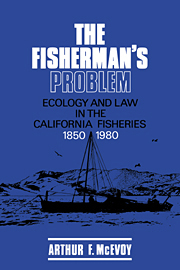Book contents
- Frontmatter
- Contents
- List of figures
- List of tables
- Preface
- Acknowledgments
- List of abbreviations
- Introduction
- I The miner's canary
- II Sun, wind, and sail, 1850–1910
- 4 Immigrant fisheries
- 5 State power and the right to fish
- III The industrial frontier, 1910–1950
- IV Enclosure of the ocean, 1950–1980
- Conclusion
- Appendixes
- Notes
- Selected bibliography
- Index
4 - Immigrant fisheries
Published online by Cambridge University Press: 06 January 2010
- Frontmatter
- Contents
- List of figures
- List of tables
- Preface
- Acknowledgments
- List of abbreviations
- Introduction
- I The miner's canary
- II Sun, wind, and sail, 1850–1910
- 4 Immigrant fisheries
- 5 State power and the right to fish
- III The industrial frontier, 1910–1950
- IV Enclosure of the ocean, 1950–1980
- Conclusion
- Appendixes
- Notes
- Selected bibliography
- Index
Summary
As a rule, they take very little interest beyond their immediate environment. … These men are first fishermen, second fishermen, third fishermen and Italians.
– Henry A. Fisk (1905)California waters supported a motley assortment of fishing enterprises during the first fifty years of statehood, just as they had while in the safekeeping of the original inhabitants. David Starr Jordan, later president of Stanford University and one of the leading ichthyologists of his day, noted in 1879 that California fishers invariably worked “within a few miles of shore by means of small vessels or boats too frail to face the dangers of the open sea. These are of diverse patterns, and the predominating types come from the central seats of antipodal civilizations.” Chinese junks mingled with lateenrigged Italian boats and New England whaleboats. Nowhere else in the United States, and possibly the world, has a fishing industry ever been so ethnically diverse.
This was partly a function of the great variety of the fishery resources that California had to offer. As immigrants struggled to recreate familiar patterns of life in their new home, they began fishing wherever they found resources to which they could adapt available skills and that they could market among people with whom they were accustomed to dealing. This was adaptation between culture and environment of a sort, but one very different from the kind that the Indians had worked out. Where aboriginal fishers had over countless seasons learned to harvest their resources so that fish and fishers alike would endure, Italians, Anglo-Saxons, Chinese, and other immigrant fishers found niches only where the stream of commerce chanced to bring them onto fertile patches along the rivers and coast.
Information
- Type
- Chapter
- Information
- The Fisherman's ProblemEcology and Law in the California Fisheries, 1850–1980, pp. 65 - 92Publisher: Cambridge University PressPrint publication year: 1986
